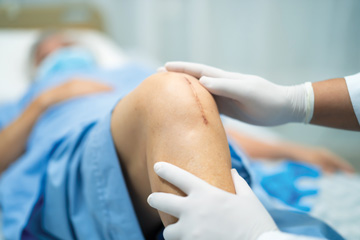• Surgeon expertise. Dr. Rubin is a proponent of employing the direct anterior approach during hip replacements, a technique that avoids cutting through muscle and allows patients to move functionally soon after surgery — leading
to less post-op pain and more rapid recoveries. He says the anterior approach also allows for more accurate implant placement and reliable outcomes.
During knee replacements, Dr. Rubin has reduced tourniquet time — he applies one for about 20 minutes as he places cement around the implant at the end of the procedure — to lessen compression on the upper thigh, which can cause muscular
injury or stasis. He makes bone cuts without the tourniquet inflated to perform dissection under hypotensive anesthesia, which allows for a meticulous hemostasis that lets him identify punctate bleeders around the joint and cauterize them
as part of his surgical approach.
Dr. Rubin has also standardized the use of tranexamic acid (TXA) during knee and hip replacements to reduce intraoperative blood loss. He administers an IV dose at the beginning of cases and injects 100 ml into the knee or hip after closing the
muscle layer at the end of procedures.
The administration of TXA is confirmed during pre-procedure time outs and discussed during post-op debriefings. “It’s important for the care team to have these types of conversations before and after surgeries to ensure no element
of the patient care protocol is missed,” says Dr. Rubin.
He has access to computer navigation technology and uses it selectively to plan surgeries for patients with complex joint disease. Another hospital within the Yale health system has invested in two robots that are used for outpatient knee replacements.
“Any technology that enhances the accuracy of component placement has the potential to give the surgical team more confidence in their ability to get patients up and walking sooner after surgery than they did in the past,” says
Dr. Rubin.
• Monitored recoveries. During recoveries from hip and knee replacement surgery, patients spend about an hour with members of the nursing team and another couple of hours with physical and occupational therapists before discharge.
It’s a structured process based on positive reinforcement. Dr. Rubin says Yale providers reworked the language of the joint replacement program’s protocols to provide guidance on what should be done instead of what must be avoided.
We moved away from prohibitive education, because studies show it doesn’t benefit patients.
— Lee Rubin, MD
“We moved away from prohibitive education, because studies show it doesn’t benefit patients,” says Dr. Rubin. “It actually causes more anxiety and doesn’t reduce rates of complications.”
For example, patients are reminded to ask for assistance before getting out of bed thanks to the effectiveness of Dr. Li’s pain management cocktails. (Remember Dr. Rubin’s phone video?) “They feel so comfortable that they forget
they just had major surgery,” she says. “We don’t want them to fall.”
Yale Medicine partnered with a home health company that sends nurses to patients’ homes the day after their discharges and the health system’s nurse navigators contact patients to check on their recoveries. Patients return 10 to 14
days after surgery for a wound check with a physician assistant and schedule a full follow-up appointment with their surgeon around six weeks post-op. At any time during their recoveries, patients can call a hotline to reach a nurse navigator
if they have concerns or questions that need an immediate response.
Dr. Rubin points to the emergence of telemedicine and patient communication apps as a significant development in the post-op care of joint replacement patients. Yale Medicine’s EMR platform has a module that allows patients to send messages
to residents, nurse coordinators, nurse navigators and physician assistants, who can quickly reply. Patients can also send pictures of their wounds if they have questions about the healing process or how the dressings look. They receive reassurance
that all is well or are asked to come into the clinic for follow-up care.
“Joint replacement programs need to provide multiple avenues for patients to communicate with providers,” says Dr. Rubin. “Patients who need follow-up care shouldn’t end up in the ER. Being able to manage patients remotely
improves their outcomes in a more cost-effective way.”
The pandemic has normalized virtual communication between patients and their providers. Yale Medicine recently surpassed one million telemedicine visits since the start of the pandemic in early 2020 after not previously offering the service. “Patients
expect to interact with their providers through some form of technology,” says Dr. Rubin. “Virtual communication platforms are evolving into the standard of care. Giving patients multiple ways to reach out is an essential calling
card for today’s providers.”
.svg?sfvrsn=be606e78_3)


.svg?sfvrsn=56b2f850_5)